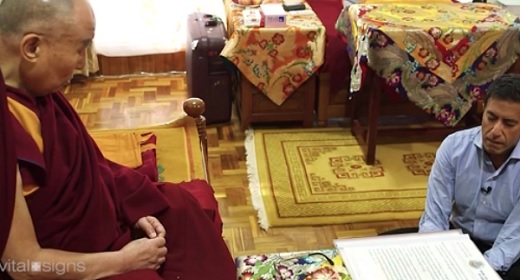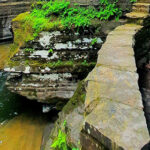by Dr. Sanjay Gupta: For the past two months, I have been a changed man. It is hard to fully describe, except to say my mood is mostly sunny and more patient than usual…

In the past, my family and friends would’ve typically described me as pleasant but hurried. My baseline restlessness and edginess, however, have now nearly vanished.
Without difficulty, I have sustained attention when my young children spend time with me. Instead of constant surveillance of my phone, there is an ability to quickly hyper-focus on the task is at hand and a corresponding joy of living in a distraction-less world.
This change seems to have started the end of last year, after I spent a morning meditating with the Dalai Lama.
First off: Yes, I do feel a little ridiculous writing a line like that, and I didn’t feel worthy of his invitation at the time. Even though I meditate, I’ve never been sure whether I was using proper technique or whether there was an acceptable way to meditate in the presence of His Holiness.
If he was looking forward to a good meditation partner, I worried he was unlikely to find it in me. Even my posture is terrible when sitting cross-legged on the floor. My back starts to hurt, followed by my knees. Thus, my breathing, which is supposed to drive my focus, sounds raspy and uneven. All this makes my mind race instead of slowing down and calming.
Just thinking about meditating with His Holiness was making me anxious.
Nevertheless, who says “no” to a chance to meditate with the Dalai Lama? I agreed to join him early the next morning at his private residence.
A practice that begins at 3 a.m.
At 81 years, old, the Dalai Lama keeps a very active schedule. I met him in Mundgod, India, at the Drepung Monastery, where he was overseeing a symposium bridging Buddhism and science.
The monastery itself is a dazzling bejeweled structure built 600 years ago. Inside, there are enormous golden Buddhas standing next to ornate walls. The discussion hall itself is grand but warm, with doors and windows open to the hot South Indian sun.
For three days, his Holiness moderated sessions on weighty metaphysical topics such as the criteria for valid reasoning, the fundamental constituents of the universe, origins of life and the subjective experience of the mind.
It was fascinating and mind-bending — but also mentally exhausting. It was difficult to stay awake, let alone keep up with the rapid-fire debate between the Buddhists and the scientists. Yet his Holiness was mentally engaged and inquisitive throughout, even more remarkable given more than half the comments were being translated for him.
The Dalai Lama typically wakes about 2:40 a.m. and starts his daily meditation routine at 3 a.m., even as most of his staff is still snoozing.
This was the backdrop when one of his senior staff members picked me up outside the monastery early one morning. We drove in a three-car convoy to the gates outside his private residence.
From there, several more staff members escorted us to a small conference room where his security detail was slowly waking and drinking their morning tea. Finally, his chief of staff walked me just outside the personal quarters of the Dalai Lama.
Meditating is hard for him, too
There were a few minor instructions before we entered. Eye contact is not a problem, and shaking hands is acceptable if you use two hands, not just one. Try not to turn your back to him when leaving the room, and instead walk backward, as much as possible facing him. When sitting cross-legged on the floor, don’t point your feet at the Dalai Lama. And the correct address is “your holiness.”
Shortly after, the doors opened, and I nervously walked into a very modest room where the Dalai Lama was sitting on a raised platform, already deep in meditation. I slipped off my shoes, sat cross-legged at a slight angle on the floor to avoid my toes being pointed in his direction, closed my eyes and started to focus on my breathing.
All my meditation insecurities immediately started to kick in. After a few minutes, I heard his deep, distinctive baritone voice: “Any questions?”
I looked up and saw his smiling face, starting to break into his characteristic head-bobbing laugh.
“This is hard for me,” I said.
“Me, too!” he exclaimed. “After doing daily for 60 years, it is still hard.”
It was at once surprising and reassuring to hear him say this. The Dalai Lama, Buddhist monk and spiritual leader of Tibet, also has trouble meditating.
“I think you will like analytical meditation,” he told me. Instead of focusing on a chosen object, as in single-point meditation, he suggested I think about a problem I was trying to solve, a topic I may have read about recently or one of the philosophical areas from the earlier sessions.
He wanted me to separate the problem or issue from everything else by placing it in a large, clear bubble. With my eyes closed, I thought of something nagging at me — something I couldn’t quite solve. As I placed the physical embodiment of this problem into the bubble, several things started to happen very naturally.
The problem was now directly in front of me, floating weightlessly. In my mind, I could rotate it, spin it or flip it upside-down. It was an exercise to develop hyper-focus.
Less intuitively, as the bubble was rising, it was also disentangling itself from any other attachments, such as subjective emotional considerations. I could visualize it, as the problem isolated itself, and came into a clear-eyed view.
Too often, we allow unrelated emotional factors to blur the elegant and practical solutions right in front of us. It can be dispiriting and frustrating. Through analytical meditation, His Holiness told me, we can use logic and reason to more clearly identify the question at hand, separate it from irrelevant considerations, erase doubt and brightly illuminate the answers. It was simple and sensible. Most important, for me — it worked.
Meditation for skeptics
As a neuroscientist, I never expected that a Buddhist monk, even the Dalai Lama, would teach me how to better incorporate deduction and critical thinking to my life — but that is what happened.
It changed me. And I am better for it. I practice analytical meditation every day, usually early in the morning. The first two minutes are still the hardest, as I create my thought bubble and let it float above me. After that, I reach what can best be described as a “flow” state, in which 20 to 30 minutes pass easily.
I am more convinced than ever that even the most ardent skeptics could find success with analytical meditation.
Over the holidays, I spent as much time as possible relaying the Dalai Lama’s teachings to my family and friends and teaching them basic principles of analytical meditation. This was the gift I most wanted to share with them. And now with you.












































